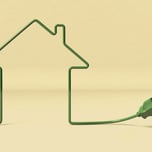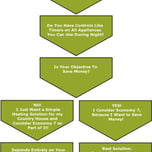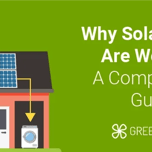- GreenMatch
- Blog
- Potential of Solar Electric Cars
Beyond the Plug: Discover the Potential of Solar Electric Cars


When we think of solar power, we usually imagine large panels on rooftops helping to power our homes - but could our cars be similarly powered by solar? Can solar panels be incorporated into the body of a vehicle so it can power itself? In short, the answer is yes!
Electric vehicles are becoming more common in our towns and cities, with increased interest due to their environmental benefits. It’s estimated that over 1 million electric cars are currently in use in the UK.
These vehicles emit up to three times less carbon dioxide than petrol cars, making them a popular eco-conscious alternative. However, sourcing clean electricity to power them is only sometimes possible. Solar-powered electric cars could be the answer for a greener, cleaner solution to our transport emissions.
In this article, we’ll look at the range of possibilities solar-powered cars bring, how they work and why their development could play a huge role in fighting climate change. We’ll also look at some existing solar electric vehicles on the market to understand their benefits and potential drawbacks.
- What are solar electric cars?
- How do solar-powered cars work?
- Comparison between solar electric cars and traditional electric vehicles
- Can you buy a solar-powered car?
- Benefits of solar cars
- Disadvantages of solar-powered cars
- Charging other electric vehicles with solar?
- Future of solar electric cars
- Frequently asked questions
What are solar electric cars?
Unlike standard electric vehicles, which need to be charged through a plug-in electric/EV charger, solar cars have unique panels built into the car's body. These panels work similarly to home solar panels, absorbing sunlight and converting it into energy.
In theory, this system would allow a car to generate its own electricity and avoid any need for external charging or harmful fossil fuels to power it. With transport in the UK responsible for nearly a quarter of the country's carbon emissions, having a vehicle that could run on clean, renewable energy is an incredible prospect.
These vehicles, however, still need to be widely produced, and although some manufacturers have produced models, there are still a number of drawbacks to overcome. The biggest issue is that solar electric cars are very expensive to produce and, therefore, expensive for the average consumer to invest in. This expense comes from the complexities of creating specialised solar panels to fit into the body of a vehicle.
How do solar-powered cars work?
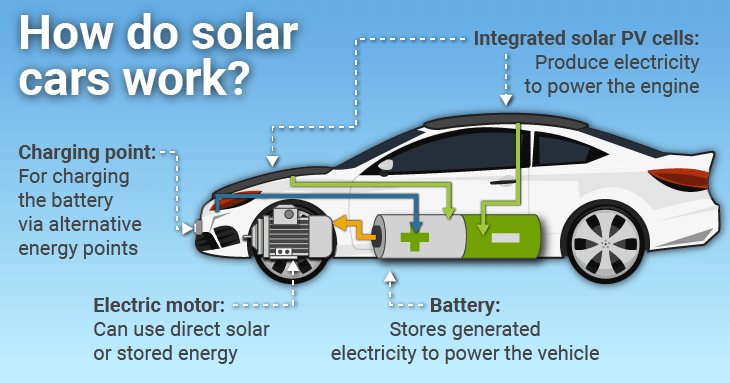
As we can see in the above diagram, solar electric cars work by incorporating highly advanced, specialised solar panels into the car's design. Often referred to as vehicle-integrated PV (photovoltaics) or VIPV, they use the same science which determines how home solar panels work.
For vehicles however, individual cells (or modules), are built-in or installed on rooftops, bonnets or side panels to ensure wide surface area coverage, allowing for the most sunlight to reach the cells. The use of smaller PV cells, rather than large panels, also means they are lighter, which is better for the vehicle's overall performance.
The solar cells can produce electricity to directly power the engine, or be stored in a solar battery pack that’s integrated into the vehicle's body. Given the right design, this clever system means solar power can be used in multiple vehicle types, including public transport such as buses, planes or trains.
Despite the complex nature of this technology, and the detail needed to incorporate it into our vehicles, more car manufacturers are starting to trial and test a solar-powered method.
Step-by-step: How do solar electric cars work
1. Solar cells: Solar cars are equipped with photovoltaic solar panels (or cells), which convert sunlight into electricity.
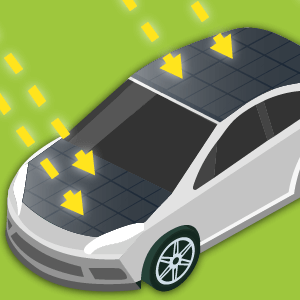
2. Electricity generation: When sunlight (photons) strikes the photovoltaic cells, it excites electrons and allows them to flow, creating an electric current.
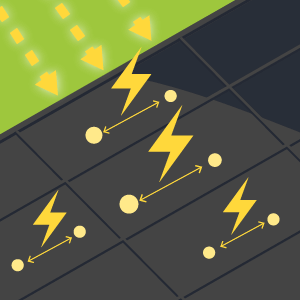
3. Powering the motor: The electricity generated from the solar panels is used to power the vehicle's electric motor.
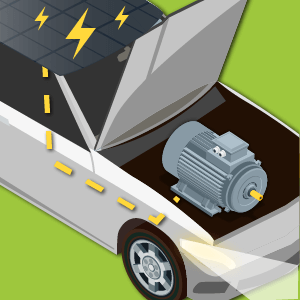
4. Battery storage: Solar vehicles typically contain a rechargeable battery to store excess energy from the solar panels, which can be used when sunlight is unavailable or insufficient.
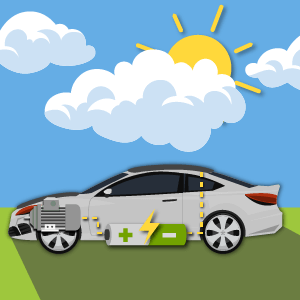
5. Regenerative braking: Some solar vehicles use regenerative braking, where the electric motor switches to generator mode, converting the moving vehicle's kinetic (motion) energy back into electricity to recharge the battery.

Comparison between solar electric cars and traditional electric vehicles
Solar and traditional electric vehicles differ in power source and charging methods. Solar vehicles can use sunlight for power, which is generated through solar panels built into the body of the vehicle. However, traditional electric vehicles must be plugged into a charging station and fed electricity from the grid or a renewable energy source.
There are some other key differences between the two vehicle types, as outlined in the table below.
| Solar Electric Vehicles | Traditional Electric Vehicles |
|---|---|
| Use a renewable energy source and reduce reliance on grid electricity | Electric vehicles can be charged from the grid, offering more flexibility in charging |
| Have the potential for unlimited range, as long as there is consistent sunlight for charging | Electric cars are not limited by climate or driving conditions and can be charged using renewable energy sources such as solar and wind power |
| Solar charging can be cheaper than grid electricity, leading to lower operating costs over the long term | Standard EVs are more technologically mature and widely available, with an established charging infrastructure |
| They have zero emissions and don’t emit any pollutants | Recover and store energy during braking, further enhancing their efficiency |
While both types of vehicles offer substantial reductions in carbon emissions compared to conventional vehicles, they differ significantly in their design, operation, and environmental impact.
The efficiency of both vehicles is influenced by factors such as energy lifecycle emissions, infrastructure requirements, and overall environmental footprint. The choice between the two depends on driving conditions and the availability of sunlight for charging on the go.
Can you buy a solar-powered car?
A solar-powered car is not something you will easily find at a local dealership. This is because the costs behind the production of these vehicles are still very high, and only a few big-name manufacturers are putting solar designs into mass production.
You can, however, get your hands on a solar electric car if you’re willing to stay on a waiting list or put down an upfront reserve payment. Only a few companies are developing solar-powered cars or putting them out for production.
Below are some of the models that are currently being marketed for purchase.
Examples of solar electric car models
Lightyear
Lightyear is a Dutch-based company that, in 2022, held a claim to launching the ‘world’s first solar car’. This electric vehicle was set to commence production as the ‘Lightyear 0’ and was widely considered to be the car that would ‘pave the way for a new era of clean mobility’.
Since its launch, Lightyear has continued to develop its technology and is now offering the Lightyear 2, a more advanced model. This car is currently available to the public, but there is a waiting list, with prices starting at £40,000.
Some of the main features include:
- 5 M² of integrated curved solar panels on its roof and bonnet
- A promise of 500 miles range between charges
- 3x fewer charges needed than a conventional EV per year
- Less than half the lifetime emissions of standard EVs
- Cars are crafted from naturally sourced materials such as plant-based leather and recycled bottle fabric
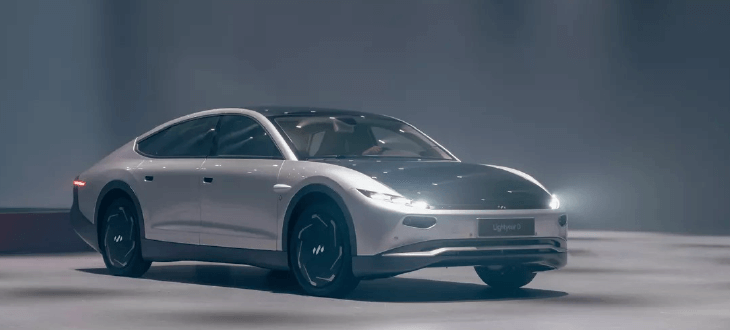
Aptera
American-based firm Aptera, is another leader in solar vehicle production. They launched in 2019 with what they claim is ‘the world’s most efficient vehicle’. Its design makes it 65% lighter than most other EVs, making it more energy-efficient.
They report that since 2019 they already have over 40,000 reservations for their solar EVs, from customers in over 100 countries. With production set to begin this year, they are now open for buyers to modify and reserve their very own vehicle.
Unlike other solar models, however, the Aptera has a unique aesthetic with space-age curves and upward-opening doors. Prices start from $33,200, with optional extras that can take you up to $48,000+.
Features include:
- Promises no charging for most daily use
- Diamond-shaped solar panels offer continuous charging with maximum sun contact, capable of charging while driving or parked
- Three-wheel design reduces the amount of energy needed
- A 1,000-mile range on a single charge, with a 40-mile solar-powered drive daily

Hyundai
Although Hyundai has not released a fully solar-powered electric vehicle, they, like some other large manufacturers, are starting to incorporate solar technology into their designs.
Back in 2019, Hyudai revealed its new solar roof charging system. Incorporated into an electric vehicle it can charge the battery while driving and improve fuel efficiency. It was claimed to be able to provide 30-60% of the car's battery charge purely via solar energy.
According to the latest updates, this solar roof can be found on the New Sonata Hybrid and is due to be rolled out across Hyundai’s other models in the future.

Stella Terra
Another noteworthy example of advances in solar vehicle technology is the Stella Terra. This is a car designed by students from the Eindhoven University of Technology, titled ‘the world's first off-road solar car’.
The car is powered by solar panels on the roof and is thought to be the most advanced solar-powered vehicle to date. It can reach top speeds of 90 mph with a charge range of 440 miles. This car is different from others as it contains a rechargeable lithium-ion battery, and the power available from the car's solar panels is strong enough to even provide electricity for cooking or charging devices.

In recent years, many tech companies and large car manufacturers, such as Toyota and Mercedes-Benz, have created new ways to incorporate solar power into their vehicles - mainly via roof panels.
Many trials, however, are still ongoing to try and make solar cells more adaptable, but the hope is that more vehicles will be available for consumer use in the future.
To understand more about why production is so complex and the driving force behind these trials, it’s important to consider the many benefits and setbacks of creating a solar-powered vehicle.
Benefits of solar cars

Sustainable transportation
The greatest benefit of solar electric cars is their sustainability. By generating their own power, they reduce the need for us to use fossil fuels as an energy source. This eliminates all of the harmful emissions we expect from standard road vehicles.
Zero emissions
Transport emissions include CO2, nitrogen oxides, particulate matter and ammonia, all of which are high-level pollutants. Not only do they impact our climate, but they are particularly harmful to human health and air quality.
Efforts to reduce these emissions are crucial for mitigating their impact, this is why solar-powered vehicles are beneficial. They don’t use a combustion process to power the engine, therefore these pollutants do not exist. Solar electric cars have zero emissions, making them healthier and more environmentally friendly than any other road vehicle option.
Cost savings
Solar-powered cars can result in significant cost savings for several reasons. Firstly, they eliminate the need for pricey fuels, which can lead to annual savings of nearly £3,000. In addition, solar vehicles don’t require the same internal moving parts as petrol or diesel cars, which in theory can result in less ongoing maintenance costs.
Advances in technology
As more work is done to trial and test solar power in vehicles, it presents further opportunities for technology to advance and become more efficient and accessible. Several car manufacturers are already integrating solar technology into their vehicles due to the advances in PV cells.
If solar cell efficiency and design improves, it could lead to more vehicles adopting the technology, further reducing our reliance on fossil fuels and improving our transport's environmental impact.
Disadvantages of solar-powered cars
Reinventing the way we power our transport is no easy task, and although solar seems like the ideal solution to our emissions problems, it’s not without its drawbacks. Incorporating solar cells into vehicles does have disadvantages and there are some key reasons we don’t already have solar electric cars on our doorstep.

Limited range
Solar-powered vehicles often have a limited drive range due to the space available for solar panels on the vehicle. The range of a solar-powered car with a full charge can vary based on the specific model and the amount of sunlight available.
The driving range can stretch from 40 to 440 miles of solar-powered drive per day depending on the model. Most will have additional range capabilities when combined with a plugin charge. The actual range, however, can be influenced by factors such as weather conditions, driving habits, and the efficiency of the solar panels.
Solar panel efficiency
As technology stands currently, solar panels are not efficient enough to power vehicles to the same extent as standard fuels. For example, a state-of-the-art solar panel can only reach an efficiency of 60%, which means users can never obtain 100% efficiency.
With this fact in mind, it’s no surprise that car manufacturers aren’t lining up to produce solar-powered cars when the current technology is not advanced enough yet to make a car which can generate adequate power to run itself.
High costs
Designing and producing a solar vehicle is an incredibly expensive process. Incorporating solar cells into a car build is very complex, and developing high-performance panels can be costly.
In fact the cost to produce a solar vehicle can be so high, that one company has already gone bankrupt trying to bring these cars to market. Demand is also not as high as you would expect - the range limitations and lack of choice mean there are not as many consumers willing to pay the cost.
Charging other electric vehicles with solar?
Despite the drawbacks of a solar vehicle, we still have the option to power our EVs with solar in different ways. Solar power gained from panels on our homes can offer us an alternative way to make use of a sustainable, low-carbon power source for our transport.
It is possible to use solar energy you generate at home to charge your vehicle, particularly if you have solar batteries which allow you to store excess energy. This can offer you a free way to power your EV charger and therefore fill your car with clean solar energy.
If solar compatible, some charging equipment can be connected to your home’s solar system inverter (this is where electricity from your panels is converted into a safe current for use in the home). This can give you direct access to solar energy for your charging point.
Solar-powered EV charging is a sustainable and environmentally friendly way to fuel your electric vehicle. It significantly reduces greenhouse gas emissions associated with conventional fuels or even grid-powered EV charging.
Installing solar panels for electric vehicles
For a typical family home, installing solar panels can cost anywhere from £6,000 to £11,000. However, the potential savings are estimated at over £400 per year. When you consider combining your solar energy with fueling your electric vehicle, further savings can still be made as you replace fossil fuel expenses.
Using this method is an all-around cleaner, more environmentally conscious way of powering your vehicle. It’s convenient, as you can charge your car at home and overnight (if you have a solar battery), so you’re ready to go in the morning.
Although installing solar panels is an upfront investment, you will be making huge savings overall. Both at home, with reduced energy bills and for your car's fuel costs, as you can effectively charge your vehicle for free.
Future of solar electric cars
Despite its many positive benefits and potentials, it’s still very early days for the solar-powered vehicle. We’re yet to see a manufacturer create a car that has it all, with the perks of free, zero emissions power but a great driving range, for a reasonable price.
Solar electric cars are the most efficient and sustainable mode of transportation we could hope for. In a world ever more crammed with harmful emissions and dangerous pollutants, seeking clean and sustainable ways to travel is vitally important.
The advances that companies such as Lightyear and Aptera are making in the electric vehicle industry are incredible. With minds like those behind the Stella Terra, we could see the dawn of even more advanced solar technology within a few years.
The solar-powered automobile industry is also expected to experience growth in the global market. Projections suggest that by 2031, the market size could reach a value of GBP 34.58 billion with a compound growth rate (CAGR) of 35.50% from 2022 to 2031.
With hopes of further capabilities in the future, lower production costs and more accessibility, we may just see the glimmer of a fully functional, everyday car powered entirely by the sun rolling onto our streets.
But, while we wait for these innovations to become reality, the sun is still shining down, ready to help us power electric vehicles today. Charging our transport with solar is the greenest and most sustainable way to clean up our transport - until our solar cars are ready!
Frequently asked questions
Yes, solar-powered cars do exist. There are currently a few models on the market, but these options are constantly growing.
Yes, the Lightyear 2 and the Aptera are both solar-powered cars available to buy or reserve starting this year.
It ranges from 500 – 1000 miles depending on the model and how you charge it.
In theory, a solar electric car can charge its battery while driving if there is ample sunlight for the solar cells to create electricity. Find out how a solar car works.

Becky is an experienced SEO content writer specialising in sustainability and renewable trends. Her background in broadcast journalism inspires reliable content to help readers live more sustainably every day.
We strive to connect our customers with the right product and supplier. Would you like to be part of GreenMatch?

- What are solar electric cars?
- How do solar-powered cars work?
- Comparison between solar electric cars and traditional electric vehicles
- Can you buy a solar-powered car?
- Benefits of solar cars
- Disadvantages of solar-powered cars
- Charging other electric vehicles with solar?
- Future of solar electric cars
- Frequently asked questions
Stay up to date with energy saving tips and grant alerts
Receive offers, marketing and promotions via email from Leads.io about GreenMatch and our brands/partners to help you save.
Thank you for subscribing to our newsletter!
Your email has been successfully added to our list. We look forward to sharing our latest updates with you soon!

